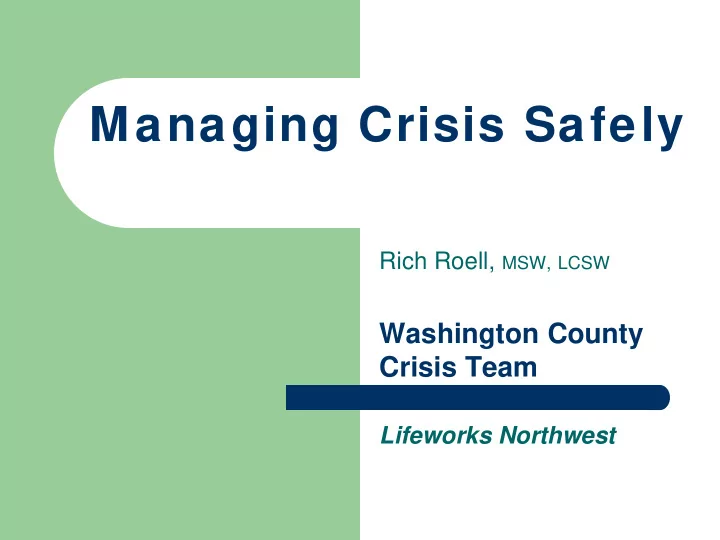

Managing Crisis Safely Rich Roell, MSW, LCSW Washington County Crisis Team Lifeworks Northwest
“Working safely may get old, but so do those who practice it.” -- author unknown
Today’s talk… Introducing the Washington County Crisis Services Your resources in a crisis Keeping each other safe Further training available Communicating in a crisis
Who we are… The Washington County Crisis Services Crisis Line (24 hrs): 503-291-9111 Hawthorn Walk-In Center – 9am-8:30pm daily 24-hour mobile crisis response also available
What we do… Urgent mental health & addictions care Psychiatric custodies (i.e. mental health holds) Crisis counseling, education & resource connection Medication bridges when appropriate All adults & children in county are eligible No charge for any of our services
Hawthorn Walk-In Center
Elam Young Parkway Site
Hawthorn Walk-In Center
Hawthorn Walk-in Center 5240 NE Elam Young Parkway (Hillsboro) right next to Hawthorn Farm MAX stop Open every day of the year, 9am – 8:30pm Free & confidential urgent care for mental health & addictions concerns
How to reach us…. Washington County Crisis Line (24 hrs) 503-291-9111 Clackamas Cty Crisis Line 503-655-8585
Who to call & when… 911 ( and then call us ) Violent threats, gestures, weapons Threatens to harm self w/ means at hand Leaves shelter suicidal or homicidal Unwanted physical contact Unresponsive or incoherent Medical emergency
Who to call & when Crisis Team (first) Ideas of harm, but safe until we arrive Non-threatening, but concerning behavior Very distressed, unable to calm Wants to speak with a counselor urgently Wants to make appt with the WCCT You want to consult
What we’ll do… Safety/mental health assessment Hospitalization (if meets criteria) Provide immediate crisis support Discuss resources Plan for follow-up
Factors for violence toward others Previous violence Substance abuse, intoxication Active mental illness, esp. w/ paranoia Negative attitudes, no insight Socially isolated, chronically unemployed High-levels of stress Lack of compliance with treatment/courts
What to be concerned about… Restlessness, agitation Angry, fearful body language Pressured speech or silence; intense staring; auditory hallucinations Disorganization, impulsiveness Fixation on a specific staff member
Safety Habits Trust your gut Safety in numbers Situational awareness Talk safety with your guests Carry your phone Code phrases Call for help, then assist
Safety Habits (cont’d) Limit self-disclosure Remember, it’s not personal Defusing ‘by choice’ What’s the plan? Practice, practice, practice It’s better to apologize for overreacting, than to regret underreacting.
GetTrainedtoHelp.com QPR (Question, Persuade & Refer) – 2 hours Adult Mental Health First Aid – 8 hours Youth Mental Health First Aid – 8 hours Applied Suicide Intervention Skills Training – 2 days ALL TRAININGS ARE CURRENTLY FREE
“People are disturbed not by things, but by the view s that they take of them.” Epictetus, 1 st Century A.D.
Serious & pervasive mental illness Mental illness disrupts a person’s normal state with powerful shifts in the brain’s neurotransmitters Physical, mental, emotional & social functioning are severely impaired, and insight is often limited Serious & untreated mental illness is usually beyond anyone’s ability to cope with alone, and frequently results in a crisis
It helps to remember… No one wants to believe they’re sick, much less mentally ill With current laws & funding, it’s difficult to get help, even for those who are motivated Meds can control symptoms, but may also create distressing & permanent side effects
Often the person is… is fearful …Be calm is confused …Be simple, truthful is insecure …Be accepting has trouble …Be brief, repetitive concentrating
Often the person is… is overstimulated …Limit input is preoccupied …Get attention first has poor judgment …Expect limitations has changing plans …Keep to one plan
Often the person is… feels ashamed …Stay positive, non-blaming has little empathy …Accept as a symptom is tired, withdrawn …Set realistic goals feels stigmatized …Don’t define the person by their symptoms
Communication specific to PSYCHOSIS, including Paranoia & Delusions Speak calmly & slowly, Limit emotion Minimize distractions Give more personal space Build rapport slowly, focus on problem-solving Roll with delusions (don’t argue or endorse)
Communication specific to MOOD DISORDERS (e.g. depression, anxiety) Speak slowly Limit input Depression feels Personal, Pervasive & Permanent Offer hope, but be honest What’s worked before? Be patient
Communication specific to PERSONALITY DISORDERS Be prepared for sudden shifts in emotions Focus on feelings to build alliance Avoid self-disclosing Expect irritation, projection of blame Keep focus on problem-solving Remember, this is about trauma
Support T HE N ATIONAL A LLIANCE FOR THE M ENTALLY I LL (NAMI) OF W ASHINGTON C OUNTY 18680 SW Shaw Street Aloha, OR 97007 503-356-6835
In closing… THANK YOU!! Please call us at 503-291-9111 if you have any questions or concerns.
Recommend
More recommend